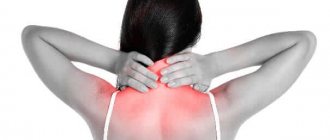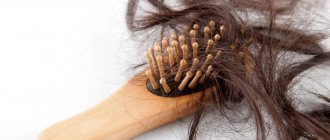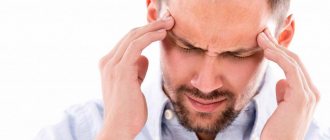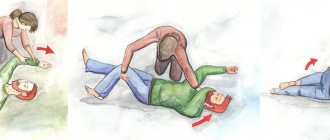Why is a pinched nerve in the lower back dangerous?
The pathology can develop at any age, but most often affects patients over 35 years of age.
A condition in which the lumbar nerve is pinched is fraught with various complications:
- muscle spasms;
- deterioration in coordination of movements;
- development of intervertebral hernia.
If a nerve is pinched, the immune defense is often weakened, and pathogenic viruses and bacteria easily enter the body. Other consequences of the pathology include sudden changes in blood pressure, dysfunction of internal organs, and the development of general weakness.
In the absence of quality therapy, the patient’s condition quickly deteriorates, accompanied by severe discomfort and loss of full performance.
general information
The sciatic nerve is the largest in the body. It is formed by branches of the spinal roots emerging from the spine at the level of 4-5 lumbar and 1-3 sacral vertebrae. The nerve passes through the piriformis foramen in the gluteal muscles and runs down the back of the buttock and thigh to the knee.
Most often, pinching occurs at the level of the lumbar spine, which is especially susceptible to the formation of hernias due to the high load when walking and sitting. Slightly less common is compression in the area of the piriform opening, which develops against the background of a sharp muscle spasm.
Make an appointment
Diagnosis of a pinched nerve root
After visiting a doctor with complaints of a pinched nerve, the following diagnostic procedures are performed:
- Examination of the patient.
- X-ray examination.
- Magnetic resonance imaging (MRI).
- Computed tomography (CT).
- Myelography.
- Electromyography.
The patient is also prescribed a general blood test and tests that indicate the presence or absence of affected nerves.
Based on the examination results, the specialist draws conclusions about the causes of the development of the pathology and begins to prescribe an adequate treatment course.
Prevention
To prevent pinching of the sciatic nerve, doctors recommend:
- normalize body weight;
- avoid carrying heavy objects;
- avoid hypothermia;
- watch your posture;
- regularly engage in sports at an amateur level to strengthen muscles, swimming has a particularly good effect;
- minimize stress;
- eat properly and balanced without overusing fatty, smoked, spicy and canned foods.
If you experience discomfort and pain in the lower back or any other area, it is important to immediately consult a doctor and undergo an examination. Osteochondrosis and other pathologies are much more amenable to correction at an early stage of development.
First aid for pinching
Sometimes it is necessary to alleviate the patient's condition urgently, before providing professional medical assistance. In such situations, perform the following actions:
- eliminate all factors that can worsen the patient’s well-being (drafts, cold, stress);
- lay the victim on a flat, hard mattress, provide him with complete rest;
- raise the lower limbs by placing several pillows under them;
- They tie the back tightly with a scarf (handkerchief) or put on a special corset.
If there is acute spasmodic pain, you can give the victim an analgesic. The approved drugs include Analgin, Paracetamol, Aspirin, Ketanov, Nise.
Diagnosis and treatment
If you have pain in your lower back and legs, you need to see an orthopedist, therapist or neurologist to get help. After studying your medical history and examination, your doctor will prescribe diagnostic tests for you. It can be:
- X-ray;
- MRI, CT;
- blood and urine tests;
- electromyography;
- Ultrasound of internal organs;
- and other procedures.
Laboratory tests and various types of examination protect the patient from misdiagnosis. For example, sometimes with pyelonephritis, for the first few days only the lower back on the right hurts and radiates to the leg. In such a situation, only a comprehensive examination will allow you to correctly determine the cause of the pain. If lower back pain that radiates to the leg is caused by diseases of the spine, then conservative treatment methods are usually used to treat it:
- taking medications;
- physiotherapy;
- physiotherapy;
- massage;
- acupuncture;
- and other procedures.
Based on the general scheme, an individual treatment plan is developed for each patient: medications, types of effects during manual therapy, and a set of therapeutic exercises are selected. Medicines coupled with physiotherapy help to quickly improve the patient’s condition:
- eliminate pain syndrome;
- eliminate inflammation and excessive muscle tension;
- restore intervertebral disc tissue, stop the growth of osteophytes;
- normalize blood circulation;
- improve sleep quality;
- return normal mobility.
Therapeutic exercise helps restore healthy spinal anatomy and correct load distribution, eliminates compression of nerve roots and blood vessels, strengthens the muscle corset and helps restore mobility. All clinics of the “Hello!” network are located close to metro stations, which is important for patients experiencing pain when walking. The use of modern diagnostic equipment, a high level of qualifications and professional responsibility of doctors, the latest treatment and rehabilitation methods allow us to quickly recognize the causes of pain and develop the most effective treatment plan for each patient.
Treatment for a pinched nerve in the lower back
When lower back compression occurs, treatment will consist of a variety of techniques. Specialists prescribe special medications, therapeutic exercises, manual therapy, and massage to patients.
In difficult cases, surgical intervention is required. Folk remedies are often given a supporting role.
Drug treatment
In order to eliminate negative symptoms and improve the patient’s condition, the following are prescribed:
- injections with drugs that relieve inflammation and pain (Movalis, Diclofenac, Ketonal, Novocaine);
- rubbing the lower back with ointments that have anti-inflammatory, warming, analgesic effects (Finalgon, Viprosal, Flexen, Betalgon).
Before prescribing certain medications, the specialist clarifies the degree of their tolerability. The duration of the medication course and dosage regimen are determined individually.
Physiotherapy
Therapeutic exercises are started after acute symptoms have been relieved. The most useful will be:
- Bend to the sides, forward.
- Walking in place with high knees.
- Swing your legs in different directions.
- Bend the legs at the knee joints, bringing them to the chest in a horizontal position.
- Riding on your back with your hands clasped around your knees.
- Twisting while lying on your side.
Training is carried out daily, for at least 10 minutes. The main goals of gymnastics are to improve blood circulation, absorption of nutrients, and activate the flow of oxygen to muscles and joints.
Manual therapy and massage
Manual therapy and massage methods can only be used as prescribed by a doctor. A manual specialist performs deep muscle work and has a pronounced effect on the lumbar spine.
The result of the doctor’s competent work is the unblocking of the existing pinching.
Massage provides a more superficial effect. This method relieves pain, improves blood and lymph circulation, and normalizes the function of the pathological nerve. Procedures performed by an experienced specialist help avoid unwanted relapse in the future.
Surgical intervention
The grounds for the operation are:
- insufficient effectiveness of conservative therapy;
- the patient has a hernia.
If the integrity of the nerve is compromised, the patient is prescribed neurosurgical intervention to restore damaged nerve threads.
This method is used in cases where the main treatment does not bring results for two or more months.
Impact with folk remedies
If a pinched nerve occurs in the lower back, treatment can be carried out using alternative medicine recipes. Traditional healers recommend using:
- Fresh celery juice (1 tablespoon inside, each time before meals). The method is also supplemented with compresses with herbal substances.
- Baths with medicinal plants (horse chestnut, oak bark, calamus root).
- Rubbing with fir oil or valerian tincture (after the procedure, the lower back is insulated with a woolen scarf or scarf).
- Honey cakes for the lumbar region.
Before starting home therapy, you must obtain your doctor’s approval and make sure you are not allergic to the components used.
How does inflammation of the sciatic nerve manifest?
Any nerve, including the sciatic one, contains several types of fibers. Sensory fibers transmit information to the brain (this is how pain is transmitted), and motor and autonomic fibers transmit signals from the brain. Inflammation of the nerve impedes conduction through all fibers, and it manifests itself as follows:
- A burning, drilling, “electric shock” pain appears in the area of the buttock, thigh or lower back. It is practically independent of physical activity and decreases little at rest and at night. This type of pain has its own name – neurogenic pain or neuralgia.
- Approximately in the same place as the pain, there is numbness and “pins and needles”. This is how the loss of the sensory function of the nerve manifests itself.
- Muscle weakness. The sciatic nerve controls the muscles of the thigh and lower leg, and the most sensitive branch, the peroneal nerve, is often affected. The patient cannot fully elevate the foot and toes.
- Hair loss, swelling, paleness or redness of the skin. The sciatic nerve carries so-called autonomic fibers. They control sweating, vascular tone in the leg, and deliver special nutrients. Inflammation often blocks these functions as well.
Kinesitherapy for pinched nerves in the lower back
A modern way to combat pathology is treatment at the Kinesitherapy Center.
The method is based on the principle of S. M. Bubnovsky. Kinesitherapy involves performing alternative gymnastics exercises and using a simulator that has both decompression and antigravity.
If you are concerned about pinching in the lower back, you should entrust the symptoms and treatment of the pathology to our specialists.
Regular training under the supervision of qualified employees will provide a lot of positive effects: they will remove pain, improve blood circulation, normalize motor activity and range of motion in the joints.
The kinesitherapy method guarantees an increase in the quality of life and restoration of working capacity. Our Centers operate in Zelenograd, Tver, Dubna and Klin.
If there is a pinched nerve in the lower back, pain, treatment must begin as soon as possible. Delay can cause dangerous complications and cause a deterioration in overall health.
Correct your posture
Since poor posture is one of the leading causes of nerve impingement, the first thing to do is improve your posture, changing it in sitting and standing positions will help relieve pain and may even reduce compression and narrowing of the nerve.
If you have a pinched nerve in the cervical spine, be sure to keep your chin in a neutral position—not too far forward or back. At the same time, your shoulders should be in a vertical plane. This position can be maintained by gently squeezing your shoulder blades together.
Always sit up straight and keep your body straight and upright while walking or standing. Don't hunch over. By focusing on maintaining proper posture, you can easily heal a pinched nerve in your neck or back.
MESSAGE FROM THE CHIEF DOCTOR:
Often, when examining a patient, doctors pay attention only to the bones, ligaments, and joints. At the same time, nothing is said about muscles
, the function of contraction of which plays a significant role in human life. Weakened muscles lead to thinning and deformed bones.
Unfortunately, common methods of therapy only aggravate the situation, leading to even more severe pain, muscle atrophy and a deterioration in the quality of life of patients.
Effective treatment is impossible to imagine without muscle restoration. Unique kinesitherapy technique
consists in a therapeutic effect, which implies, first of all, muscle activity during the methodical execution of a set of exercises on special simulators.
All exercises are performed by patients sitting or lying down, so there is no excessive stress on the joints and circulatory system, and our instructors-methodologists correct the technique of movements
and monitor the correct execution of actions.
Remember that diseases of the spine and joints are not a death sentence; if the patient wishes and the right approach to treatment, everything can be corrected!
Causes
The list of causes of pinched sciatic nerve includes:
- osteochondrosis of the lumbar and sacral spine, protrusion and herniation of intervertebral discs; as a result, there is a narrowing of the spinal canal and compression of the roots that form the nerve;
- spinal injuries;
- postural disorders, scoliosis of the lumbar spine;
- diseases of the hip joint, especially arthrosis;
- myofascial pain syndrome: a sharp muscle spasm associated with severe pain, for example, due to a bruise or an unsuccessful injection;
- prolonged excessive stress on the pelvic muscles (for example, being in an uncomfortable position);
- inflammatory diseases of the pelvic organs, accompanied by a reflex spasm of muscle fibers;
- hypothermia;
- space-occupying formations in the area of the sciatic nerve: benign and malignant tumors, abscesses;
- pregnancy: infringement occurs against the background of pressure from the enlarged uterus on nearby structures.
The risk of developing entrapment increases significantly:
- against the background of excess body weight;
- with insufficient intake of minerals from food;
- for acute or chronic intoxication (salts of heavy metals, alcohol, drugs);
- with herpes zoster, which is localized in the area of the sciatic nerve.











